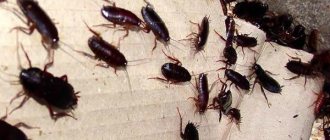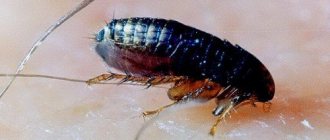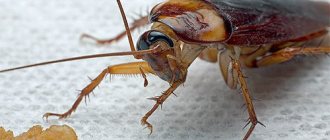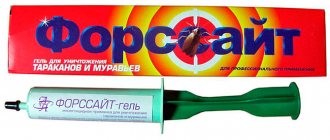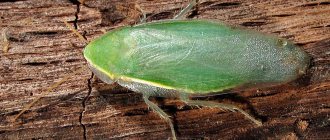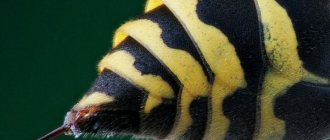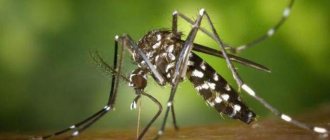Cockroaches - small, unpleasant apartment dwellers - always cause a feeling of disgust, rejection and hostility, since their appearance causes a lot of problems for the owner of the living space. For a long time, the mustachioed insect manages to remain unnoticed (since it is nocturnal), lives quietly in comfortable conditions and slowly reproduces. If the mustachioed creature had the temerity to catch the eye of the apartment owner, it means that there are quite a lot of insects, so you need to get rid of them urgently. Why is it not recommended for a person to calmly, so to speak, coexist like a neighbor with cockroaches?
What do small cockroaches look like?
A well-known saying says: “You need to know your enemy by sight.” What do small cockroaches look like? Such insects are characterized by a wide abdomen, short wings and a flat body shape. The most important organ of the body is the tactile antennae, which provide the insect with orientation in space. Three pairs of legs are equipped with suction cups and claws that help them move on any surface. The high speed and agility inherent in small cockroaches determine their penetration into the narrowest cracks, moving not only in the space of the apartment, but also in basements, sewers, attics, and garbage chutes.
Cockroaches are carriers of disease
From walks on their chitinous coverings, cockroaches bring a lot of different pathogenic bacteria, helminth eggs and fungal spores that come across along their intricate route. In just a few hours, this entire set can end up on the kitchen table, food and dishes. In addition, cockroaches - small pests - are omnivores and are equipped with mouthparts that can grind any food. A considerable range of pathogenic microorganisms is also present in the digestive system of cockroaches and can cause diseases such as pneumonia, meningitis, gastroenteritis, dysentery, salmonellosis, and mycobacteriosis.
The danger comes from the chitinous coverings remaining after molting, the remains of dead individuals, and dry excrement. When mixed with house dust, such substances enter the human skin, digestive tract, and respiratory tract and can cause a number of serious diseases, including allergic rhinitis, bronchial asthma, and dermatitis.
The presence of mustachioed insects can be determined by the unpleasant odor in the apartment, which most often comes from black cockroaches. This is especially noticeable when there is a significant accumulation of them. How to get rid of domestic cockroaches in an apartment?
Other types of cockroaches
There are several more representatives of the squad who, although rarely, appear in apartments. They come from other countries and settle in a limited area, as a rule, in the southern regions of Russia, where the climate is warmer:
- Turkmen or Central Asian cockroach - has a brown color, turning into black towards the back of the body, there are no wings, the body is elongated.
- The Egyptian cockroach is painted in a rich black color, the body shape is close to round.
Separately, furniture cockroaches should be highlighted. They were discovered relatively recently, just a few decades ago. A distinctive feature of these creatures is their light, uneven color - on their abdomen all shades of brown in the form of spots or stripes.
They feed on paper, fabrics, glue, and because of this they often settle in libraries, bedrooms or offices. They mostly live in central Russia.
About little black cockroaches
The black cockroach is a prominent representative of its compatriots; it enters apartments mainly from sewers, basements and garbage cans. It has been observed that this individual does not rise above the 5th floor, so it causes the greatest trouble to residents of the lower levels. Small black cockroaches in an apartment, the presence of which indicates poor sanitary conditions in the room, do not disdain any food; in its absence, they feed on scraps from the trash can.
In terms of reproduction speed, they are superior to their red counterparts, who also prefer to live close to humans.
The red cockroach (in common parlance “Prusak”), characterized by an elongated body and light red color, has become so firmly established in living quarters that getting rid of it and its brethren is a rather tedious and time-consuming task.
By the way, such insects regulate the number of their numerous colonies independently.
Redheads (Blattella germanica)
If we consider the types of domestic cockroaches, this is the most popular family. It is also known as Prussians. No living space is immune from the appearance of red cockroaches.
It is worth noting that it is very difficult to get rid of them - insects know how to hide well, reproduce with incredible speed, and chemicals or traditional methods of killing cockroaches are ineffective.
Types of cockroaches
You can meet red cockroaches almost everywhere:
- Living spaces;
- hospitals;
- public places;
- utility rooms;
- country houses.
The body of the cockroach is slightly elongated, the chitinous shell has a reddish tint, which can range from light to very dark. Representatives of such an interesting family live near a large amount of food. Incredibly, they easily manage to penetrate even closed containers.
Types of red cockroaches
Interesting facts from the life of red cockroaches - they can find food almost everywhere. Even if you carefully hide all the leftover food, insects will easily find a few grains of sugar spilled a long time ago or stale bread crumbs.
The presence of water is vital for representatives of this family. They can go without food for a long time, but if the taps in the apartment are faulty, then the cockroaches will calmly continue to visit, constantly visiting the source of life-giving for them. They will not disdain indoor plants either - young shoots may be completely eaten.
If small cockroaches appear: what to do?
An effective drug in the fight against cockroaches is the Dichlorvos aerosol, which ensures the rapid death of insects provided that they are outside their burrows at the time of treatment. The surviving individuals, after the chemical wears off, will calmly return to their previous way of life. The disadvantage of using this method is the risk of poisoning pets with toxic chemical vapors, for which such treatment can sometimes even lead to death.
Small cockroaches in the bathroom, kitchen and apartment in general can be destroyed with gels (“Dohlox”, “Liquidator”, “Killer”, “Raptor”), sold in large syringes and ready for immediate use. The product should be applied along the baseboard around the perimeter of the room in small drops at a distance of about 10 cm from each other. In just a week, cockroaches will not come to stay in the apartment they have lived in and will leave it forever.
Traps against cockroaches
Safer and more effective in the fight against cockroaches are traps (for example, Raid or Raptor), which are small round boxes with poison inside and several entrances.
Such devices are equipped with special Velcro, so they can be attached almost anywhere. A long period of exposure, safety, absence of fumes and harmful odor are the advantages of using such products. A red cockroach that has been trapped becomes infected and infects the rest of its relatives.
The main synanthropic species of cockroaches
The diversity of cockroaches includes several thousand species and varieties, but only a few of them are able to live in apartment conditions, and even fewer are resistant to methods of combating them.
Adapting or escaping to another place, they continue to live next to a person, use his home and eat leftover food.
Favorable factors for cockroaches living in residential premises:
- constant air temperature about +25 degrees;
- high humidity, dampness;
- darkened places in the home: behind furniture, baseboards, in cracks; it is especially comfortable for insects to live behind the refrigerator;
- availability of food and water.
If these pests have settled in such a room, it will be very difficult to remove them. Tropical conditions in the house allow insects to actively reproduce, increasing their offspring tens and even hundreds of times annually.
Against cockroaches – boric acid
You can “treat” cockroaches with the most dangerous poison for them, causing death - boric acid. It is recommended to sprinkle this powder on the area where the trash can is, baseboards, sinks, ventilation holes, bathrooms, and toilets. For humans, such a drug, inexpensive in cost, is completely harmless, so you can safely sprinkle it on suspicious surfaces. It is worth considering that insects are very sensitive to powder that is harmful to them and most of them sense it a mile away. In this case, you can play on a specific feature of cockroaches: curiosity.
Whiskered insects are very curious. If, for example, you put a bright candy wrapper on the windowsill and watch it for a while, then a cockroach or even several will definitely appear in your field of vision and approach an unfamiliar object in order to examine it.
Therefore, boric acid can be disguised as an attractive ball. To prepare the poison, you need to mix 30-50 grams of the drug powder with raw egg yolk (or bread crumbs or grated potatoes) until it becomes mushy. Then you need to stick small balls (about 1 cm in diameter) and place them in places where a massive accumulation of cockroaches is expected to occur. It is advisable to perform this operation at night. Small cockroaches will not feel the disguised boric acid, but they will definitely begin to explore the ball itself and, touching it with their antennae, will doom themselves to death.
Since insects do not transmit a signal of danger to their relatives, new individuals will approach the cunning bait, become infected and crawl away mortally ill. Using this method, you can completely get rid of cockroaches in 3-4 weeks, depending on their number. There is a possibility of cockroaches reappearing; it may be the hatched offspring left in the eggs by the female insect. Therefore, it is recommended to repeat the method with boric acid, and the cockroaches - small and large - will disappear forever.
Types of domestic cockroaches: photos and descriptions
American and furniture are types of domestic cockroaches that appeared in Russia relatively recently; you will find their photos and descriptions below.
American cockroach
- The species name in Latin is Periplaneta americana.
- It has been found in Russia approximately since the early 90s of the last century.
- It is the largest synanthropic cockroach among those living in Russia.
- The body size of an adult insect reaches 4–5 centimeters.
- The ootheca during the breeding season reaches a length of 7–8 millimeters, increasing the size of the female’s body to 5–6 centimeters.
- Color red-brown or brown.
- There are long cerci in the caudal part.
- The insect has wings, it sometimes flies or jumps using its wings, but for the most part it still runs.
- The cockroach moves very quickly - its speed is 5.4 kilometers per hour.
- Female American cockroaches live about 3 years, males - about 1.5.
- The female lays a new batch of eggs approximately every month.
- Each ootheca contains 16 eggs.
- The larvae look like smaller copies of adult insects, but do not have wings.
- Immediately after hatching, the larvae of American cockroaches are dirty white, darken with age, grow and acquire their traditional color.
- American cockroaches feed on human food, pet food, and excrement in sewers and drains.
- The most favorable temperature for life and reproduction is plus 30–35 degrees.
- So far, it is most often found in heated basements, greenhouses, winter gardens, and in the area of underground heating communications, from where it can creep into residential and non-residential premises.
Brown-banded cockroach
- The species name in Latin is Supella longipalpa.
- May also be called furniture cockroach, brown banded cockroach, or brown banded cockroach.
- Ethiopia is considered the homeland of this species of cockroaches.
- It appeared in Russia in the 70s of the last century.
- Externally, the brown-striped cockroach looks like a red one; you can determine that these are different insects by two dark stripes on the head; furniture cockroaches do not have them, while Prussians always have them.
- The body color of the insect is dark brown, chocolate, beige in places transparent with a tint of the main color.
- On the back there are two brown, as if singed spots of a darker shade than the body, because of which the insect got its name.
- The adult size reaches 1.5 centimeters in length.
- The ootheca is up to 5 millimeters long, which increases the size of the female during the breeding season to 2 centimeters.
- The insect has wings, but only males willingly use them.
- There are up to 18 eggs in one clutch.
- During her life, one female lays eggs up to 20 times.
- Several females attach cocoons with eggs in the same place, 50–60 oothecae next to each other.
- The eggs of furniture cockroaches have a greenish tint.
- Depending on environmental conditions, the larva goes through all stages of transformation in 1.5–4 months.
- An adult insect lives about 80 days.
- The larvae are similar to adult insects, but are smaller and have two wide, transverse light beige stripes just behind the head, which disappear with age.
- The most comfortable temperature for life is plus 30 degrees.
- It is less demanding of moisture than other types of cockroaches, so it can settle in furniture, bedrooms, corridors, things and be found in other dry places that are usually unusual for cockroaches.
These species are often found in Moscow, as well as other large cities in the European part of Russia. With a high degree of probability, we can assume that their numbers will gradually increase in the coming years, although there is no reason yet to say that they will displace black and, especially, red cockroaches.
Killer composition: flour + alabaster
An effective remedy for cockroaches - red, rather unpleasant insects - is a combination of alabaster and flour in equal proportions. The resulting mixture should be sprinkled on the areas where insects are most concentrated. When alabaster enters the body, it hardens and turns into plaster, which causes the death of mustachioed individuals.
Cockroaches are small, brown and black insects that cannot stand the smell of ammonia, so a washed floor with the addition of this substance will repel them for a while.
Beer against cockroaches
You can insidiously take advantage of the love of cockroaches for beer by pouring a small amount into the bottom of a jar, greasing the inner edges of the glass container with Vaseline and leaving it in the place where the insects are supposed to live. The next morning the jar will be filled with cockroaches. With this method, only those specimens that crawl out of their holes will die. Females involved in laying eggs and packing them into the ooteca, a special chamber at the end of the abdomen, will remain inside and are guaranteed to ensure the appearance of new offspring instead of the destroyed ones.
Red cockroaches - a way of life
Lifestyle is nocturnal.
Lifestyle – they love group parties.
Although cockroaches are closely related to termites, they are not as social as termites. Termite colonies have an organized social structure in which different members play different roles. Cockroaches do not have such roles, but they prefer to live in groups.
Research shows that groups of cockroaches make collective decisions about where to live, and that cockroaches have a collective mind made up of the decisions of individual cockroaches. European scientists have developed a robot called InsBot that can imitate the behavior of cockroaches. The researchers applied cockroach pheromones to the robot to make real cockroaches accept it.
By taking advantage of cockroaches' tendency to follow each other, InsBot was able to influence the behavior of entire groups, including convincing cockroaches to leave the shadows and move into illuminated areas. Scientists suggest that such robots could be used to herd animals or control cockroach populations.
Curious facts
Those who like to kill cockroaches in a sudden way should be aware of the extreme resistance of such insects to physical damage. Therefore, swatting it down is not enough; you also need to either grind it thoroughly, or sprinkle it with boric acid while still half-dead and release it to its relatives.
Interesting information: thanks to a specific gene, called “knockdown” by scientists, cockroaches can imitate their own death. Smelling the smell of poison, the insect loses consciousness, falls with its paws up and stops breathing.
After lying down for a certain period, he comes to his senses and calmly continues his sabotage activities.
Preventive measures
As preventive measures against the spread of cockroaches in the home, it is recommended to use the following recommendations:
- Maintain perfect cleanliness in the kitchen and in the apartment as a whole. There should be no crumbs on the tables and floors, and greasy deposits on the walls. The trash can should be taken out in a timely manner, without putting it off until tomorrow.
- Store seasonings in glass, hermetically sealed containers.
- Wash dishes and sinks promptly.
- Do not leave containers with prepared food or grocery bags open.
- Cover the air vents with a grill or fine mesh.
- Cockroaches can live for several weeks without a head, which has been confirmed by repeated experiments.
- Many species can fly (the synanthropic American or Lapland cockroach).
- Whiskered insects may not breathe for 40 minutes. This property contributes to the retention of water available in the body when it is impossible to replenish it.
American cockroach
In appearance, the American cockroach is similar to the Prussian cockroach. It has the same red or brown color on its belly and wings. They can be distinguished from other relatives by their size; they are large, up to 50 mm in length, and by dark brown spots on their bodies. The wings of males exceed the size of the abdomen, while those of females are slightly shortened. They can fly and jump. Long whiskers allow them to find food and detect air vibrations.
The American cockroach looks similar to the red Prusak
They settle mainly in sewers, heating mains and basements. They spread into apartments through ventilation shafts. They move very quickly, up to 75 cm per second.
The homeland of the American cockroach is Africa, from there it moved to North and South America, and then came to Europe. They are not often found in Russia; the more tenacious and prolific Prussians displace them from their habitats.
